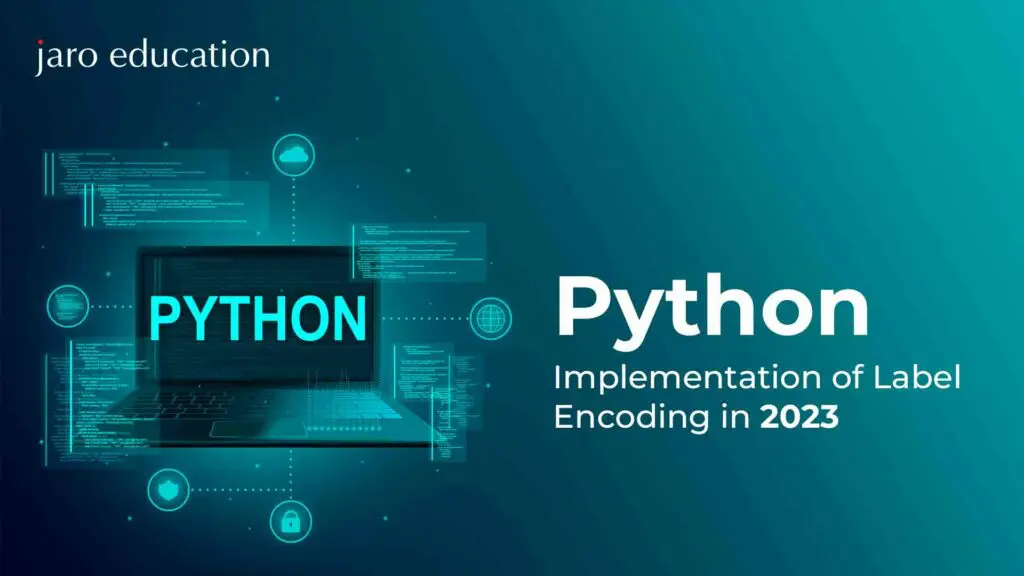Python Implementation of Label Encoding in 2023

In machine learning and data analysis, the label encoding approach is used to translate category variables into numeric form. Given that most machine learning models can only function on numerical data, it is very helpful when applying methods that need numerical input.
Consider applying to IIM Kozhikode Professional Certificate Programme in Advanced Analytics & Business Intelligence to improve your knowledge of Python and advanced analytics skills. The designed curriculum includes thorough instruction in Python, a potent programming language frequently used in data science. The programme is carefully planned to fit your work responsibilities, allowing you to advance your skills and equip yourself with the newest Python tools and techniques in the data science industry. Take advantage of this chance to increase your knowledge and maintain your lead in the quickly developing field of data analytics.
Classification of data
Data refers to distinct types of information that are typically formatted in specific ways. You can classify data into three categories: structured data, semi-structured data, and unstructured data.Structured data refers to data represented in the form of a matrix with rows and columns. It can be stored as a table in an SQL database, rows and columns in an Excel spreadsheet, or delimited data in a CSV file.
Table of Contents
Semi-structured data and unstructured data, on the other hand, do not conform to the matrix structure. Semi-structured data is typically stored in formats such as XML files or JSON, while unstructured data can be images, emails, videos, log data, or textual data.
Python implementation label encoding converts categorical data into a numerical representation by giving each category a special numerical label. Categorical data, or qualitative or nominal data, represents information that can be divided into distinct categories or groups. Here are some common types of categorical data:
- Nominal Data:
Nominal data consists of categories with no inherent order or ranking. Examples include colours (example: red, blue, green) and marital status (example: single, married, divorced).
- Ordinal Data:
Ordinal data represents categories with a natural order or ranking. The intervals between categories may not be equal, but the order is meaningful. Examples include educational attainment (high school, bachelor’s degree, master’s degree), survey ratings (strongly disagree, disagree, neutral, agree, strongly agree), or socioeconomic status (low, medium, high).
Ways of Python Implementation of Label Encoding
There are two ways of Python implementation of label encoding, they are:
- LabelEncoder class using scikit-learn library
- Category codes
Label Encoder class using the scikit-learn library
To perform label encoding in Python using the ‘LabelEncoder’ class from the ‘sklearn.preprocessing’ library, follow these steps:
Step 1:
Import the necessary libraries
Input: from sklearn.preprocessing import LabelEncoder
Step 2:
Provide input of the LabelEncoder class
Input: label_encoder = LabelEncoder()
Step 3:
Set the label encoder to the categorical data
Input: label_encoder.fit(categorical_data)
Step 4:
Convert the categorical data into numerical labels:
Input: encoded_data = label_encoder.transform(categorical_data)
The transform method takes the original categorical data and returns an array with the corresponding numerical labels.
Step 5:
(Optional) In order to reverse the encoding and obtain the original categorical values, you can use the inverse_transform method
Input: original_data = label_encoder.inverse_transform(encoded_data)
Make sure to replace categorical_data with the actual variable or array containing your categorical values.
Many columns or features may be simultaneously subjected to label encoding. For each classified column, you can repeat the steps from 3 to 5. It is crucial to remember that label encoding adds an arbitrary order to the categorical values, which could cause the model to make false assumptions. Use one-hot encoding or alternative approaches, like ordinal encoding, which offer more suitable forms for categorical data, to get around this problem.
A quick and efficient method for transforming category information into a numerical form is label encoding. You may quickly encode your category data and get it ready for additional analysis or input into machine learning algorithms by using the LabelEncoder class from scikit-learn.
Category Codes
Let’s use COVID-19 examples throughout states across the nation as an example to illustrate label encoding. The State column in the data frame below has a machine-unfriendly category value, while the other columns each have a number. Let’s encode the labels for the State column. After label encoding, the numeric value is assigned to each of the categorical variables in the graphic below. The numbering is assigned according to alphabetical order, so it is not in sequence(Top-Bottom). Gujarat in 0, then Kerala in 1 and then so on.|
States (Nominal Scale) |
States (Label Encoding) |
|---|---|
|
West Bengal |
5 |
|
Kerala |
1 |
|
Madhya Pradesh |
2 |
|
Gujarat |
0 |
|
Orissa |
3 |
|
Uttar Pradesh |
4 |
Since you already noticed that the “State” column datatype is an object type by default, you must use pandas to change “State” into a category type. By executing covid19[“State,” we can retrieve the codes for the various categories.cat.codes. The fact that label encoding introduces a relationship between categories when there typically isn’t one potential problem with label encoding.
In the mentioned example of six classes in the above for the “State” column, the relationship between two columns looks like: 0 < 1 < 2 < 3 < 4 < 5. It implies that algorithms may mistakenly interpret numeric values as containing some type of order.
Limitation of Python Implementation of Label Encoding
Categorical data is converted into numerical representations using a technique called label encoding. Its drawback is that each type of data is given a special number, starting at 0. As a result, when training models with such data sets, unwanted priority correlations may be created. For instance, a label with a higher allocated value than a label with a lower allocated value can be incorrectly thought to have greater importance.
What is One-Hot Encoding?
The majority of algorithms for machine learning in use today cannot operate on data that is categorical. As an alternative, categorical data must first be changed into numbers. The technique used to carry out this conversion is one-hot encoding. This approach is typically employed when applying deep learning methods to issues involving consecutive classification.
Categorical variables are essentially represented as binary vectors in one-hot encoding. First, integer values are assigned to these categorical values. Then, every value of an integer is expressed as a binary vector made up of zeros only.
Difference Between One-Hot Encoding and Label Encoding
| One-Hot Encoding | Label Encoding |
| One-Hot encoding is a binary representation of categorical variables where each category is converted into a binary vector. | Label encoding is a technique where each category is assigned a unique numerical label. |
| Generates a binary matrix where each category has its own column, and the presence of a category is represented by 1, while the absence is represented by 0. | Produces a single column of numerical labels corresponding to each category. |
| Increases the dimensionality of the dataset as it creates multiple columns (equal to the number of categories) | Does not increase the dimensionality; it replaces categories with numerical labels. |
| One-Hot encoding is suitable when the categorical variables do not have an inherent order or hierarchy. | Label encoding can be useful when there is an inherent order or ranking in the categories. |
| One-Hot encoding does not lead to any loss of information as it preserves the individual categories. | Label encoding may introduce an implicit ordinal relationship between the labels, which can be misinterpreted by the model. |
| Some machine learning algorithms, such as logistic regression, can have difficulty handling high-dimensional datasets resulting from One-Hot encoding. | Label encoding is generally compatible with most algorithms, as it represents categories with numerical values. |
| Example: Suppose we have three categories: ‘Red,’ ‘Green,’ and ‘Blue.’ One-Hot encoding would create three columns: ‘Red,’ ‘Green,’ and ‘Blue.’ Each category would have its own column with values 1 or 0. | Example: Using Label encoding, ‘Red’ might be represented as 1, ‘Green’ as 2, and ‘Blue’ as 3, with a single column. |
Conclusion
Label encoding is a potent method for converting categorical data into a numerical form suitable with machine learning methods. In this blog, we analysed label encoding in Python and covered its positive aspects and different methods. You can successfully implement label encoding in your data by following the provided instructions.
Becoming a skilled data scientist requires more than just perfecting label encoding. Maintain your curiosity, investigate additional preprocessing methods, and keep learning about the changing subject of data science. In case you are searching for professional assistance, enrol in the offered by IIM Kozhikode. It is a comprehensive programme that helps improve advanced analytics abilities. You will learn important skills in this fast-expanding industry by taking this thorough course on data science and advanced analytics.
Participate in peer networking opportunities across different industries and develop skilled leadership skills as part of this prestigious programme. To ensure a successful career in the field of advanced analytics and data science, apply for this programme through Jaro Education.

Popular courses
Admission Open

Post Graduate Certificate Programme in General Management – IIM Nagpur
- Duration: 12 Months
- Application Closure Date: 30th October, 2024
Admission Open

Post Graduate Certificate Programme in Applied Data Science & AI – IIT Roorkee
- Duration: 6-8 Months
- Application Closure Date: 10th September 2024
Admission Open

Financial Reporting and Corporate Governance IIM Ahmedabad
- Duration: 4 Months
- Application Closure Date: 5th August 2024





